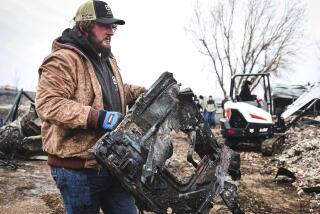Texas Drought Aid Area Is Expanded
- Share via
BOYD, Texas — Gazing across a field of shrunken watermelons on withered vines, Agriculture Secretary Dan Glickman promised federal aid to four more counties in drought-stricken North Texas on Tuesday.
Glickman’s visit marked the 60th consecutive day without measurable rainfall in North Texas, where crops are parched and reservoirs are drying up. The record before this year was 58 days, set in 1934 and 1950.
“These folks are really hurting,” he said. “I don’t like to be here on a day setting records--not these kinds of records anyway.”
Glickman had previously declared 153 Texas counties either primary or contiguous agricultural disaster areas.
He said low-interest loans may provide some short-term relief to farmers facing a bleak situation, but if the dry weather continues, officials will be forced to find other ways to help.
“Drought is even more an insidious natural disaster than, let’s say, a hurricane or floods or tornadoes, because it happens very slowly,” Glickman said. “Its impact is more long-range, far-reaching.”
Farmers agree.
Samie Erwin, 65, who owns the 400-acre farm Glickman toured, said the dry weather the last few summers is just as bad as the Dust Bowl and the drought in the early 1950s.
Erwin’s son-in-law, Jimmy Gentry, who helps on the farm about 70 miles northwest of Fort Worth, said he has lost at least half his crop.
“This is just about disaster,” Gentry said. “I’ve been farming 17 years, and I’ve never seen it this bad.”
Drought conditions since 1996 have caused more than $5 billion in losses to farmers statewide, said Allen Spelce, spokesman for the Texas Department of Agriculture.
Although there was plenty of rainfall in 1997, agricultural losses totaled $2.1 billion in 1996 and 1998. Last year the drought led to losses of $223 million. Losses so far this year are $595 million.
Farmers say the only real relief is rain. But that isn’t likely to happen any time soon, according to the National Weather Service.
The extended forecast for North Texas calls for clear skies with a slight chance of rain late next week.
Bill Proenza of the National Weather Service office in Fort Worth, said the weather pattern called La Nina has led to drought in much of the southern United States, which appears to be waning.
That may mean normal rainfall in September, although it may not be enough to make up for the two-month deficit, he said.
More to Read
Sign up for Essential California
The most important California stories and recommendations in your inbox every morning.
You may occasionally receive promotional content from the Los Angeles Times.













